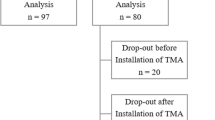Abstract
Purpose
Telemonitoring is being increasingly used for chronic disease monitoring. While the primary aim of telemonitoring is to improve chronic disease management and decrease hospitalizations, the potential impact on patient’s health-related quality of life may be an additional benefit.
Methods
Two hundred and five patients aged 60 years and older with multiple medical conditions were enrolled in a one-year randomized controlled trial of daily home telemonitoring. Health-related quality of life was measured with the 12-Item Short-Form at the beginning and at the completion of the study. Per protocol analysis of the 166 patients responding to the follow-up survey was performed.
Results
Among the 166 responders, there were no significant differences at baseline in the physical component summary (PCS) scores (p value = 0.32), nor the mental component summary (MCS) scores (p value = 0.12) between the telemonitored group and the usual care group. There was also no difference in the 12-month PCS scores (p value = 0.39) or MCS scores (p value = 0.10) between groups. There was no difference in the change from baseline to 12-month MCS scores between groups (p value = 0.89); however, there was a significant difference in the baseline to 12-month change of PCS scores between groups, with the telemonitored group having a greater decrease in PCS scores (−4.3 ± 9.3), compared to the usual care group (−1.2 ± 8.5) over the course of the study (p value = 0.03).
Conclusion
Home telemonitoring in older adults with multiple comorbidities does not significantly improve self-perception of mental well-being (as measured by MCS scores) and may worsen self-perception of physical health (as measured by PCS scores).
Similar content being viewed by others
References
Partnership for Solutions National Program Office. (2004). Chronic conditions: Making the case for ongoing care. http://www.partnershipforsolutions.org/DMS/files/chronicbook2004.pdf Accessed 25 January 2012.
Institute of Medicine. (2008). Retooling for an aging America. Washington, DC: National Academies Press.
Speedie, S. M., Johnston, B., Cox, R., Antoniotti, N., & Lindsey, J. (2007). Telehealth and health care provider shortages. http://www.americantelemed.org/files/public/policy/Telehealth_and_the_Provider_Shortage.pdf Accessed 16 February 2012.
Pare, G., Moqadem, K., Pineau, G., & St-Hilaire, C. (2010). Clinical effects of home telemonitoring in the context of diabetes, asthma, heart failure and hypertension: A systematic review. Journal of Medical Internet Research, 12(2), e21.
Inglis, S. C., Clark, R. A., McAlister, F. A., Ball, J., Lewinter, C., & Cullington, D, et al. (2010). Structured telephone support or telemonitoring programmes for patients with chronic heart failure. Cochrane Database Systematic Review, 8, CD007228.
Improving the Health and Health Care of Older Americans. (2012). A report of the AHRQ task force on aging. http://www.ahrq.gov/research/olderam/oldam1.htm. Accessed 6 March 2012.
Boaz, M., Hellman, K., & Wainstein, J. (2009). An automated telemedicine system improves patient-reported well-being. Diabetes Technology & Therapeutics, 11(3), 181–186. doi:10.1089/dia.2008.0048.
Lewis, K. E., Annandale, J. A., Warm, D. L., Hurlin, C., Lewis, M. J., & Lewis, L. (2010). Home telemonitoring and quality of life in stable, optimised chronic obstructive pulmonary disease. Journal of Telemedicine and Telecare, 16(5), 253–259.
Hopp, F., Woodbridge, P., Subramanian, U., Copeland, L., Smith, D., & Lowery, J. (2006). Outcomes associated with a home care telehealth intervention. Telemedicine Journal e-Health, 12(3), 297–307. doi:10.1089/tmj.2006.12.297.
Noel, H. C., Vogel, D. C., Erdos, J. J., Cornwall, D., & Levin, F. (2004). Home telehealth reduces healthcare costs. Telemedicine Journal e-Health, 10(2), 170–183.
Takahashi, P. Y., Hanson, G. J., Pecina, J. L., Stroebel, R. J., Chaudhry, R., Shah, N. D., & Naessens, J. M. (2010). A randomized controlled trial of telemonitoring in older adults with multiple chronic conditions: The Tele-ERA study. BMC Health Services Research, 10, 255.
Takahashi, P. Y., Pecina, J. L., Upatising, B., Chaudhry, R., Shah, N. D., & Van Houten, H. et al. (2012). A randomized controlled trial of telemonitoring in older adults with multiple health issues to prevent hospitalizations and emergency department visits. Archives of Internal Medicine. doi: 10.1001/archinternmed.2012.256.
Crane, S. J., Tung, E. E., Hanson, G. J., Cha, S., Chaudhry, R., & Takahashi, P. Y. (2010). Use of an electronic administrative database to identify older community dwelling adults at high-risk for hospitalization or emergency department visits: The elders risk assessment index. BMC Health Services Research, 10(1), 338. doi:10.1186/1472-6963-10-338.
Ware, J., Jr, Kosinski, M., & Keller, S. D. (1996). A 12-item short-form health survey: Construction of scales and preliminary tests of reliability and validity. Medical Care, 34(3), 220–233.
Erickson, S. R., Williams, B. C., & Gruppen, L. D. (2004). Relationship between symptoms and health-related quality of life in patients treated for hypertension. Pharmacotherapy, 24(3), 344–350.
Antoniades, N. C., Rochford, P. D., Pretto, J. J., Pierce, R. J., Gogler, J., Steinkrug, J., et al. (2012). Pilot study of remote telemonitoring in COPD. Telemedicine Journal and e-Health: The Official Journal of the American Telemedicine Association, 18(8), 634–640. doi:10.1089/tmj.2011.0231.
Clark, R. A., Inglis, S. C., McAlister, F. A., Cleland, J. G., & Stewart, S. (2007). Telemonitoring or structured telephone support programmes for patients with chronic heart failure: systematic review and meta-analysis. British Medical Journal, 334(7600), 942.
Acknowledgments
This study was funded by Mayo Clinic institutional funds for clinical support, by grant 1 UL1 RRo24150 from the National Center for Research Resources of the National Institutes of Health (NIH) and by the NIH Roadmap for Medical Research. The Intel Health Guide telemonitors and support were provided by Care Innovations (Intel-GE).
Author information
Authors and Affiliations
Corresponding author
Rights and permissions
About this article
Cite this article
Pecina, J.L., Hanson, G.J., Van Houten, H. et al. Impact of telemonitoring on older adults health-related quality of life: the Tele-ERA study. Qual Life Res 22, 2315–2321 (2013). https://doi.org/10.1007/s11136-013-0361-5
Accepted:
Published:
Issue Date:
DOI: https://doi.org/10.1007/s11136-013-0361-5




